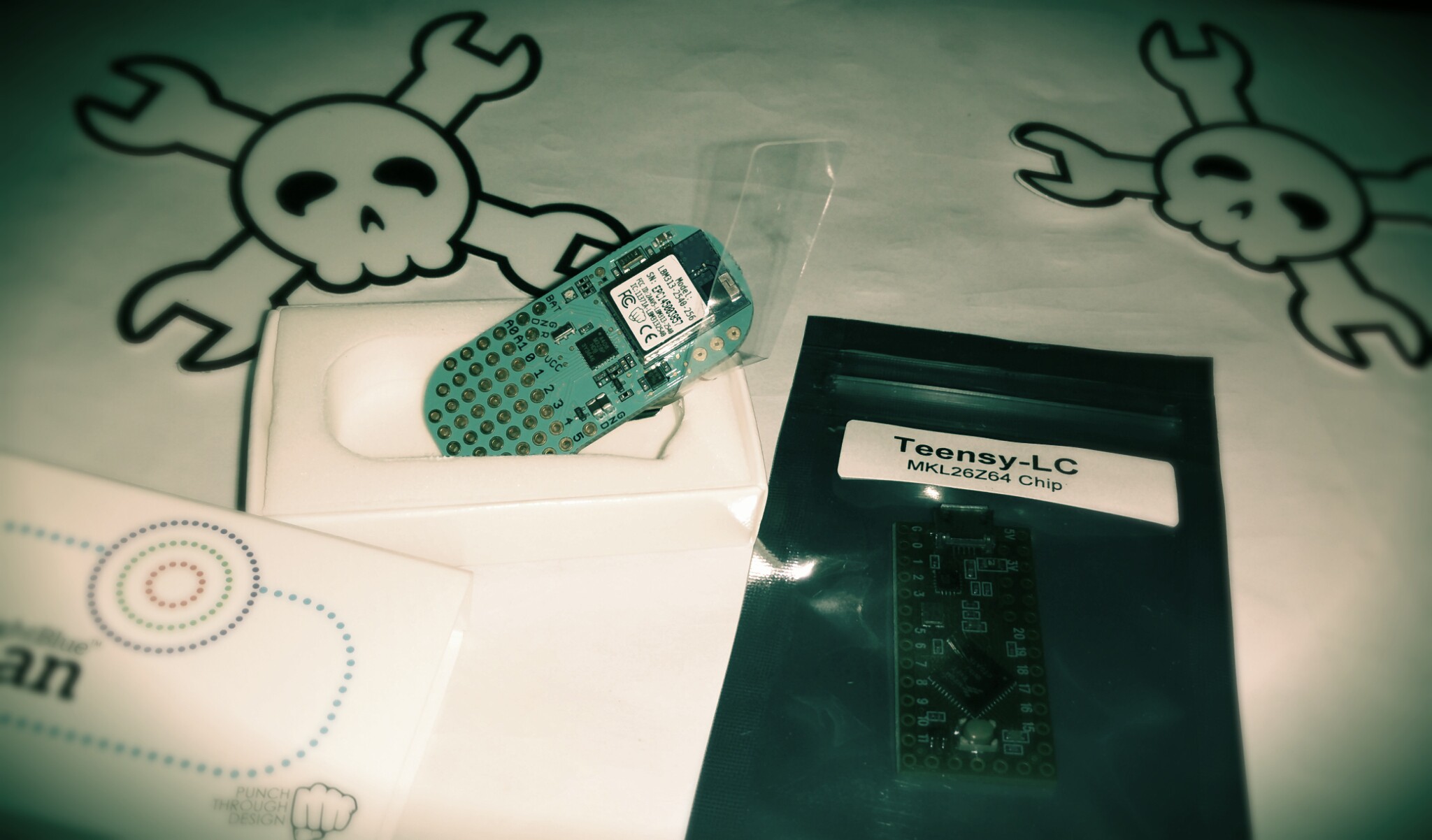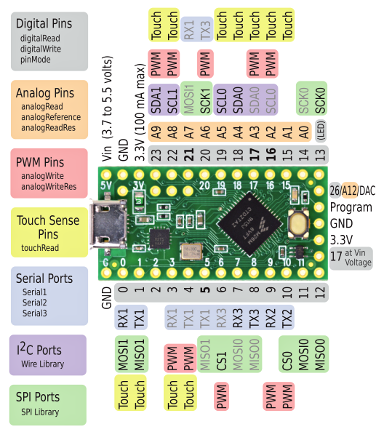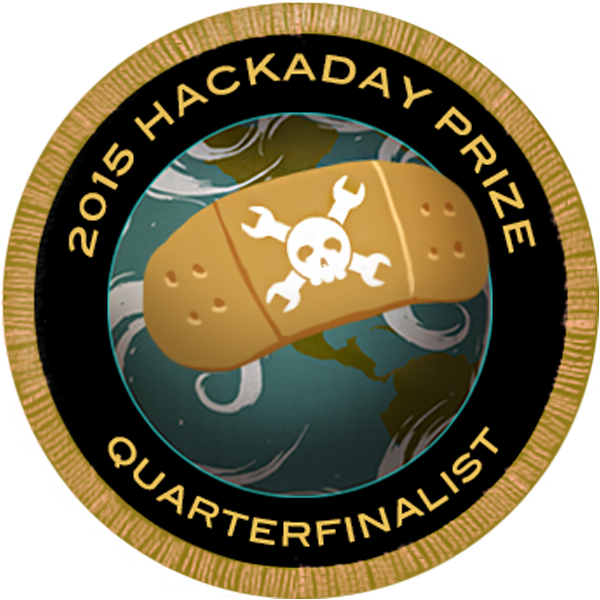-
Teensy LC - Hackaday win
06/03/2015 at 00:18 • 2 commentsAs part of the recurring competition on hackaday I managed to score some winnings!
Sadly Mr Postman had other ideas than delivering my items when arrived so that's why I'm late to the game...

This is my first Teensy board so after a quick Google-session I quickly found the drivers and toolchain I needed, and I decided to download Teensyduino 1.23 to see how compatible it was with a selected few of my Arduino sketches?!
The installer for Windows, Linux or Mac OS-X can be found here: http://www.pjrc.com/teensy/td_download.html
Before tinkering commenced I had a quick look at the pinout of the Teensy-LC and it's a more than competent little trinket this one! :)
Teensy-LC has a MKL26Z64VFT4 Cortex-M0+ microcontroller that runs upto 48 MHz, but is possible to run at 24 MHz if needed. It has 62 kbytes of flash mem and 8 kbytes of RAM.
It has both plenty of digital and analogue pins (27+13), PWM pins, Touch Sense pins, three serial ports, I2C and SPI. Most pins are 3.3v@5mA but four pins are 3.3v@20mA. One pin (pin 17) is also 5v and I suspect this is more or less just VIN going "out" to a pin. This is great since we now can drive WS2812b LEDs directly from the Teensy-LC! How many LEDs in reality is next to be tested but first I need to see if a sketch compiles, and loads without any problem.

Picture made by Nantonos.
First I loaded a "blinky" sketch to see if all compiled and flashed, and so it did! Pin 13 is the LED pin on the Teensy-LC and so far so good. What about my http://hackaday.io project Glediator-from-sdcard? Will it compile even though I'm using FastLED and SD libraries? Well here we go:
Build options changed, rebuilding all In file included from Glediator-simple2.ino:5:0: D:\dev\arduino-1.6.3\hardware\teensy\avr\libraries\FastLED/FastLED.h:12:2: warning: #warning FastLED version 3001000 (Not really a warning, just telling you here.) [-Wcpp] #warning FastLED version 3001000 (Not really a warning, just telling you here.) ^ Opening Teensy Loader... Sketch uses 20 024 bytes (31%) of program storage space. Maximum is 63 488 bytes. Global variables use 3 276 bytes (39%) of dynamic memory, leaving 4 916 bytes for local variables. Maximum is 8 192 bytes.
No problems at all! :D Whoever wrote the Teensyduino library did a really good job because it was seemingly seamless!
It's running late here so I'm leaving the proper test to see if it can drive 80 WS2812b on a WS2801 LED strip tomorrow, and I shall put the scope on it to see if it has the power to drive these favourite LEDs of mine... Can it do it or will the magic smoke make an appearance when pushed a bit? ;)
It's not the go-to microcontroller if you have really big sketches since it "only" has ~62 kbytes of flash memory, but with optimised code you should be able to squeeze in quite a few lines of code until you do run out of memory. I've seen amazing stuff done with only 4k so you should be able to do quite a few things here until you run out!
A quick observation tells me that it's not more difficult to program and flash a Teensy-LC than an Arduino UNO - even for a beginner. The installer from PJRC is great and also imports the most common (Teensy verified) libraries into Arduino IDE for you if you want. For me the minute form-factor was a massive bonus, and I might use these a lot in the future instead of my own miniaturized Atmega328 boards. The price is certainly hard to beat with regards to what you actually get!
I'm impressed!
To be continued...
Thank you Hackaday for giving us hackers out there freebies which we otherwise might have not have acquired. :)
-
LightBlue Bean - Hackaday win
06/03/2015 at 00:16 • 0 commentsAs part of the recurring competition on hackaday I managed to score some winnings!
Sadly Mr Postman had other ideas than delivering my items when arrived so that's why I'm late to the game...

This is a placeholder whilst I make something cool with the LightBlue Bean and where I shall do a writeup of what I thought of it!
Thank you Hackaday for giving us hackers out there freebies which we otherwise might have not have acquired. :)
My Pages
Things I've Built
Timstock for Sony Smartwatch
Built a Timstock for Sony Smartwatch for fun during a weekend. It works great according to my oldest son (who's using it daily), but perhaps a bit too expensive for everyone?...
Tim(mer) Stock
The Tim(mer) Stock is an Android app that recycles old and discarded phones into a Timstock so that autistic kids can have access to a really important tool - which costs more than $200 to buy... It is available for free in Google Play.
Projects I Like & Follow
Share this profile
ShareBits
Become a Hackaday.io Member
Create an account to leave a comment. Already have an account? Log In.
davedarko
wrote 05/24/2015 at 08:15
•
point
I like the Idea of sponsoring - this way believers can also pay for it and you're able to give them to sceptic persons for free etc. Good luck with your project(s)!


 jens.andree
jens.andree M. Bindhammer
M. Bindhammer kodera2t
kodera2t Pierre-Loup M.
Pierre-Loup M. plinio
plinio Voja Antonic
Voja Antonic davedarko
davedarko Jason Bowling
Jason Bowling David Shamblin
David Shamblin

Thank you all for following my work and also for giving me your skulls!!! It means a lot for me and for what I'm trying to do in life :)
I try to make something useful from my tinkering and I try to help those who have it difficult in life - especially kids, and although I think it's important for everyone to make money in life I loath companies that tries to make big money on others misfortune, and this is why I focus on making available tools for autistic kids around the world - fully Open Source and profit-free!
I plan to set-up a system where people can donate a Timstock Slim to a child who can't afford one - even though they will be 100% profit-free and hopefully not more expensive than a pizza, but that'll have to wait until the first version is released.
Happy tinkering!